最新第五讲-高中英语状语从句详解
- 格式:doc
- 大小:63.50 KB
- 文档页数:10
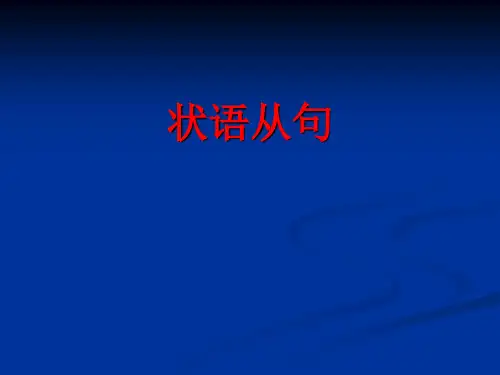


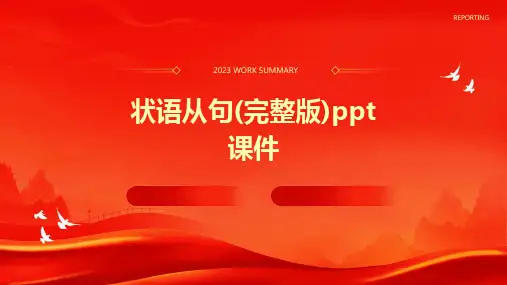
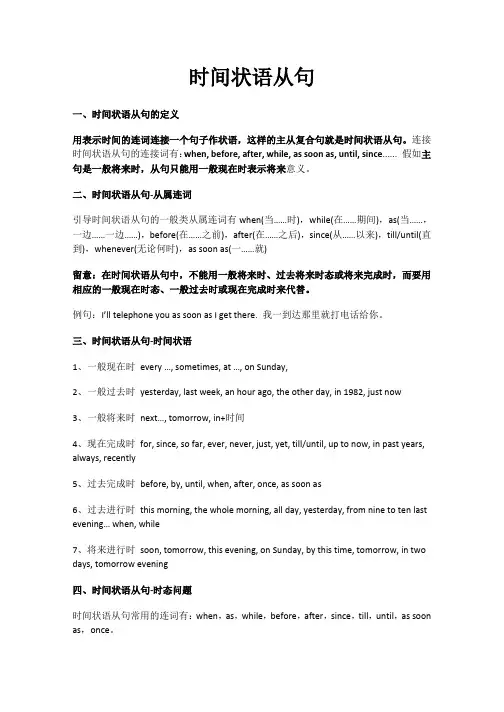
时间状语从句一、时间状语从句的定义用表示时间的连词连接一个句子作状语,这样的主从复合句就是时间状语从句。
连接时间状语从句的连接词有:when, before, after, while, as soon as, until, since...... 假如主句是一般将来时,从句只能用一般现在时表示将来意义。
二、时间状语从句-从属连词引导时间状语从句的一般类从属连词有when(当……时),while(在……期间),as(当……,一边……一边……),before(在……之前),after(在……之后),since(从……以来),till/until(直到),whenever(无论何时),as soon as(一……就)留意:在时间状语从句中,不能用一般将来时、过去将来时态或将来完成时,而要用相应的一般现在时态、一般过去时或现在完成时来代替。
例句:I’ll telephone you as soon as I get there. 我一到达那里就打电话给你。
三、时间状语从句-时间状语1、一般现在时every …, sometimes, at …, on Sunday,2、一般过去时yesterday, last week, an hour ago, the other day, in 1982, just now3、一般将来时next…, tomorrow, in+时间4、现在完成时for, since, so far, ever, never, just, yet, till/until, up to now, in past years, always, recently5、过去完成时before, by, until, when, after, once, as soon as6、过去进行时this morning, the whole morning, all day, yesterday, from nine to ten last evening… when, while7、将来进行时soon, tomorrow, this evening, on Sunday, by this time, tomorrow, in two days, tomorrow evening四、时间状语从句-时态问题时间状语从句常用的连词有:when,as,while,before,after,since,till,until,as soon as,once。
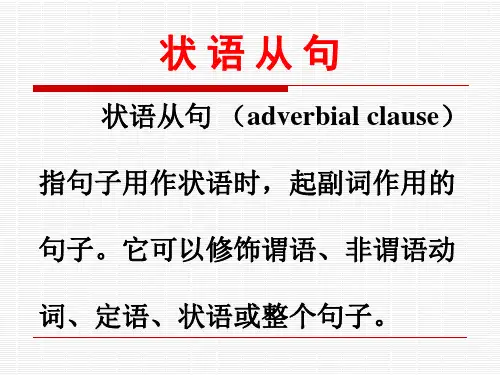
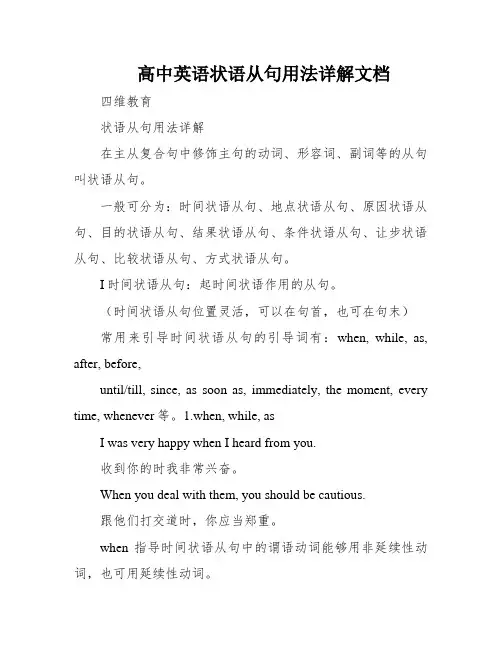
高中英语状语从句用法详解文档四维教育状语从句用法详解在主从复合句中修饰主句的动词、形容词、副词等的从句叫状语从句。
一般可分为:时间状语从句、地点状语从句、原因状语从句、目的状语从句、结果状语从句、条件状语从句、让步状语从句、比较状语从句、方式状语从句。
I时间状语从句:起时间状语作用的从句。
(时间状语从句位置灵活,可以在句首,也可在句末)常用来引导时间状语从句的引导词有:when, while, as, after, before,until/till, since, as soon as, immediately, the moment, every time, whenever等。
1.when, while, asI was very happy when I heard from you.收到你的时我非常兴奋。
When you deal with them, you should be cautious.跟他们打交道时,你应当郑重。
when指导时间状语从句中的谓语动词能够用非延续性动词,也可用延续性动词。
When I was young, I went to town myself.当我还年青时,我本人独自去城里。
(延续性动词)When I lived in country, I used to carry some water for him.我住在农村时,常常为他担水。
(延续性动词)When he received the letter, he'll tell us.当他接到后,他会告诉我们的。
(非延续性动词)When the fire broke out, all the students were sleeping soundly.火灾发生时,所有的学生正在熟睡。
(非延续性动词)注意:当when引导的时间状语从句为系表结构,而且其主语和主句的主语一致,其表语又是一个名词时,就能够用由as指导的省略句来代替when指导的从句。

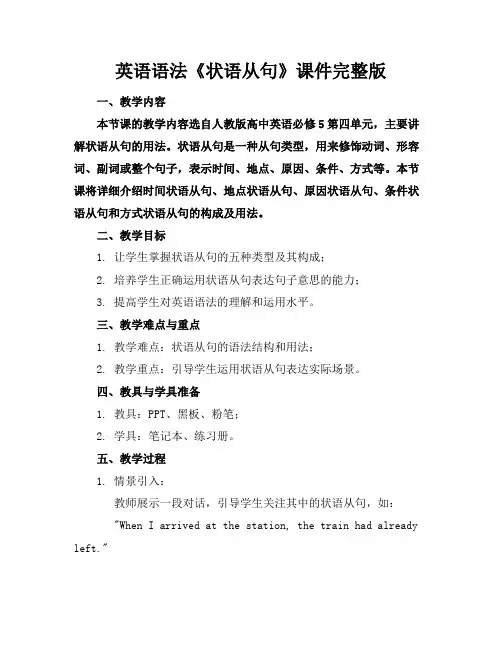
英语语法《状语从句》课件完整版一、教学内容本节课的教学内容选自人教版高中英语必修5第四单元,主要讲解状语从句的用法。
状语从句是一种从句类型,用来修饰动词、形容词、副词或整个句子,表示时间、地点、原因、条件、方式等。
本节课将详细介绍时间状语从句、地点状语从句、原因状语从句、条件状语从句和方式状语从句的构成及用法。
二、教学目标1. 让学生掌握状语从句的五种类型及其构成;2. 培养学生正确运用状语从句表达句子意思的能力;3. 提高学生对英语语法的理解和运用水平。
三、教学难点与重点1. 教学难点:状语从句的语法结构和用法;2. 教学重点:引导学生运用状语从句表达实际场景。
四、教具与学具准备1. 教具:PPT、黑板、粉笔;2. 学具:笔记本、练习册。
五、教学过程1. 情景引入:教师展示一段对话,引导学生关注其中的状语从句,如: "When I arrived at the station, the train had already left.""If you need any help, please don't hesitate to ask me."让学生分析这些状语从句的类型和用法。
2. 知识讲解:教师运用PPT展示状语从句的五种类型,分别为:a) 时间状语从句:如when, after, before, as soon as等;b) 地点状语从句:如where, wherever, in which等;c) 原因状语从句:如because, since, as等;d) 条件状语从句:如if, unless, until等;e) 方式状语从句:如as, as if, as though等。
教师举例讲解每种状语从句的构成和用法,让学生进行随堂练习。
3. 例题讲解:教师展示一些状语从句的例题,如:"I will go to the party if I finish my work.""He waited for her in the hall, wherever she might be."让学生分析这些例题的状语从句类型和用法,并进行小组讨论。


第五讲:状语从句一、状语从句的概念在句中用作状语的从句叫状语从句(adverbial clause)。
引导状语从句的关联词是从属连词。
如:1) When you cross a main road, you must be careful.2) I was late because I missed the bus.3)If she doesn’t write to me first, I will not write to her.4) I have lived here since I was a child.5) I’ll show you so that you can see how it’s done.上述例句中的黑体单词就是引导状语从句的从属连词,斜体部分则是状语从句。
从例句中可以看出,状语从句的位置比较灵活:可以置于句首,也可以置于句末。
若从句置于句首时,其后常用一个逗号。
状语从句根据其表达的含义和用途可分为:时间状语从句、地点状语从句、原因状语从句、条件状语从句、让步状语从句、比较状语从句、方式状语从句等。
二、状语从句的种类1. 时间状语从句(Adverbial Clauses of Time:)时间状语从句由从属连词when, while, as, before, after, since, until, till, once, as soon as, whenever等引导。
翻译下列句子,注意各个连词的含义:①When he comes here tomorrow, I’ll call you.②Henry is in charge of the office when Mr. Smith is away.③I was watching an interesting TV play when the telephone rang.④While he was walking in the street, he met Tim.⑤She often listens to her diskman while she is doing her homework.⑥As spring warms the good earth, all flowers begin to bloom.⑦As I was going out, it began to rain.⑧He had worked in a factory before he entered the college.⑨It is two years since his father died.⑽It is two years since he smoked.⑾He stayed in school until his father came to fetch him.⑿I didn’t leave until his father came to fetch him.⒀Once you understand the rules, you will find it easy to play the games.⒁He was shot dead before he could let out a cry.⒂Three years had passed before we knew it.⒃He was always sitting before his computer whenever I went to see him.另外,名词短语every time, each time, the moment / the minute(一……就……), by the time, next time, the first / second…/ last time等和副词immediately, directly (一……就……), 也可以当作连词使用引导时间状语从句,并在高考试题中出现过。
状语从句句子的类型句子:简单句并列句复合句:●名词性从句:主语从句、宾语从句、表语从句、同位语从句●状语从句●定语从句什么是状语状语时用来修饰词,词,词或的一种句子成分。
它可以表示时间、地点、原因、目的、结果、条件、让步、比较、方式等。
当充当状语的部分是一个句子时,也就是状语从句,来说明一件事情发生的时间,地点,原因,条件,结果等。
分类如下:状语从句1. 时间状语从句2. 地点状语从句3. 原因状语从句4. 条件状语从句5. 让步状语从句6. 目的状语从句7. 结果状语从句8. 方式状语从句9. 比较状语从句1. While I was wondering at this, our schoolmaster took his place. ( )2. Where there is a will, there is a way. ( )3. Now that/Since everybody is here, let’s begin our meeting. ()4. I’ll speak slowly so that you can understand me. ( )5. So clever was he a student that he was able to work out all the difficult problems. ( )6. As long as you don’t lose heart, you’ll succeed. ()7. He is unhappy, though he has a lot of money.8. The old lady treats the boy as if he were his own son. ( )一.时间状语从句(一)用when, while或as 填空:1._____________ we were talking, Mr Smiths came in.2._____ they came home, I was cooking dinner.3.I was about to go to bed _______ I heard someone knock at t the door.(并列句)4. ________ we were watching TV, he was studying.5. He is fat _______ his brother is thin. (并列句)6. _____she sang, tears ran down her face.A 从句为‖当……的时候‖,从句谓语为延续性动词,主句谓语为非延续性动词(即终止性动词), 三者可通用.B 当从句的谓语动词为终止性动词,只能用when; 表示―正在那时‖, 也只能用when.C.从句和主句的谓语动词都为延续性动词时, 只能用while; while还可作并列连词,表示‖而‖.D. 当强调主句和从句的动作同时发生时,只能用as, 译为“正当…;一边…一边…; 随着…”________he talked on, he got more and more excited.________ you grow older ,you will know better and better about yourself.They talked ______they walked along the river.(二)“一…就”除用as soon as 外,还可用the moment、immediately、no sooner…than, hardly…when 等。
高考英语语法复习状语从句知识讲解一、概述常见的有although/though/even though引导的让步状语从句。
if/unless引导的条件状语从句。
until/when/while/as soon as引导的时间状语从句。
because引导的原因状语从句,so that引导的目的状语从句等。
if引导的条件状语从句和when引导的时间状语从句一般都会和时态相结合,即主要考查“主将从现”原则。
对于状语从句的学习可与专题六从属连词相结合。
在时间状语从句和条件状语从句中,主句和从句的时态一致问题一般有两种情况:(1)“主将从现”:主句用一般将来时,而从句用一般现在时。
常见的使用“主将从现”原则的连词有:表示时间的when, while, after, before, until, till, whenever, as soon as, as long as, once 等;表示条件的if, unless, so long as, in case等。
(2)“主祈从现”:若主句是祈使句,或主句中有情态动词时,那么从句用一般现在时表示将来。
(3)“主情从现”:若主句有情态动词, 那么从句用一般现在时表示将来。
如:You can get good grades if you study hard.如果你努力学习,你将取得好成绩。
状语从句由从属连词引导,与主句连接,位于句首时,常用逗号与主句分开,位于句末时,其前一般不用逗号。
状语从句根据其用途可分为时间状语从句、条件状语从句、原因状语从句、目的状语从句、结果状语从句、让步状语从句、比较状语从句、地点状语从句等。
二、时间状语从句(1)当主句是一般将来时态或祈使句,表示将来的意义时,从句通常用一般现在时,简称“主将从现”。
I’ll ring you up as soon as I get to Beijing.我一到北京就给你打电话。
(2) when引导的时间状语从句,通常表示主句和从句的动作同时发生;before表示主句的动作发生在从句的动作之前;after则表示主句的动作发生在从句的动作之后;as引导时间状语从句时,往往表示主句和从句的动作同时发生,不分先后。
状语从句状语从句在句中作状语,可分为:时间、条件、让步、原因、目的、结果、比较、地点、方式状语从句。
一、时间状语从句引导时间状语从句的连词有:when, as, while, until, not…until, before, after, since, the minute, the moment, each( every, next, the first) time等。
时间状语从句中一般用一般现在时或一般过去时。
1.When , while, as都可解释为“当```的时候”但侧重点有所不同。
1)WhenEg: When I arrived home , I had a little rest.注意点:when 从句的主语与主句主语相同,谓语动词是be 动词时,从句主语和be可以省略。
Eg: When (she was) walking along the street, she met her class teacher.2)AsAs 除了表示“当```的时候”,还可表示为“一面```一面”,“随着”Eg: He sang as he danced.(一面```一面)You will grow wiser as you grow older.(随着)3)While表示“当```的时候”强调主句的动作和从句的动作同时发生,从句一般用进行时,从句动词必须是延续性动词。
Eg: While we were working, they were having a rest.While (they were) having a discussion, they got very confused.注意点:while 有对比的含义,解释为“然而”。
eg: I prefer black tee, while he likes coffee.2.until, not…until表示“直到```才”,在肯定句中主句常用延续性动词;在否定句中主句常用短暂性动词。
状语从句一:状语从句的定义、功能、分类定义:在复合句中作状语的从句功能:状语从句在主从复合句中修饰主句中的动词,形容词或副词,或整个主句分类:按意义可分为时间、地点、原因、目的、结果、条件、方式、比较、让步等状语从句。
位置:从句的位置放在句首,也可放在句末。
放在句首时,从句后面常用一个逗号,放在句末时,从句前一般不用逗号。
二:考点与难点1、各种从属连词的含义及用法比较;2、no matter wh- 与wh-ever 引导的从句的区别;3、状语从句的时态问题;4、状语从句倒装及省略;5、状语从句与其它从句的区别。
三:九种常见状语从句用法1. 时间状语从句引导时间状语从句的从属连词1).基本类:before、after、when、while、as、since、till、until、once, as soon as, etc.2). 名词类the moment ,the minute, the second, the instant,etc. (一…就…); every time, each time, the last time, the first time, the day, the year, the morning etc.3). 副词类:immediately, directly, instantly, etc. (一...就...)4).句型类:no sooner…than…, hardly/scarcely…when…, etc. (一…就…)注意:1. when, as, whileWhen ①when表示时间点时,从句中用短暂性动词;表示时间段时,用持续性动词。
Eg:. When they were still talking and laughing, the teacher came in. (when表示段时间)2). He waved a hello when he saw her.(when表示点时间)②. 可用作并列连词,其意义为“这时,突然”,相当于and then suddenly。
常用于下列句式:be doing / be about to do sth/ be on the point of doing / have/had done + when Eg.1). I was about to go out when the door bell rang.2). One evening I was having my dinner when an unexpected friend knocked my door.③. 还可以表示原因,意思是“既然”,相当于since; considering thatEg. 1). It was foolish of you to take a taxi when you could easily walk there in five minutes .2). How can he get good grades when he won't study?While ①while通常表示一段时间,从句中常用持续性动词作谓语。
Eg: Strike while the iron is hot. 趁热打铁。
②while有时可以作并列连词,表示对比,可译成“然而……”。
Eg: 1). I am fond of English while he likes maths.③while有时可引导让步状语从句,意思是“虽然”。
Eg. While they love the children, they are strict with them.As ①表示一边……一边……,强调从句和主句中两个动作交替进行或同步进行。
eg: She is singing a song as she took a bath.②as表示随着eg: As time goes on, it's getting warmer and warmer.2. till, until和not…until1)until /till用于肯定句时,表示直到…为止,主句必须为持续性动词。
eg: We shall wait until / till he comes back.2)Not……until/till表示直到……才,主句通常要用短暂性动词。
eg: People do not know the value of their health till/ until they lose it.3) 当not until位于句首时,主句中的主语、谓语要使用倒装语序。
eg: 直到那时,我才知道我错了。
Not until then did I know I was wrong.3. before:1.We had sailed four days and four nights before we saw land. “……才2.We hadn’t run a mile before he felt tired. “不到……就”3.Please write it down before you forget it. “趁……”4.Before I could remember a word, he had checked me. “还没来得及”5. 句型It will be/was+段时间+before…“还要过多久才……”如:还有2年他才离国。
It will be two years before he leaves the country.6. 句型It will be/was not+一段时间+before…“没过多久就……”。
如:没过2年他就离国了It wasn’t two years before he left the country.4.since, ever since1.Since:自……以来。
表示动作从过去某一点时间一直延续到说话时间为止。
主句中通常为现在完成时,从句中一般用一般过去时。
Eg: 1). 自从我上次见你,你到哪里去了Where have you been since I last saw you。
2.ever since 从那时起直至现在,此后一直。
Eg: He has been sad ever since the death of his wife.2). 从她小时候起,她就一直在集邮。
Since she was young, she has been collecting stamps. 句型It is/has been+段时间+since…Eg: 1). It’s two years since he was a college student.他大学毕业已有两年了2). It has been just a week since we arrived here. 我们到那里有一个星期了。
5. “一……就……”表达法:1) as soon as...Eg.一下课我就去厕所I went to the toilet as soon as the class was over.2) Immediately,instantly ,directlyEg:他一到家马上就给她打了电话。
They phoned her immediately they reached home.3) the moment, the minute, the instant, the secondEg: 1).他说他一回家就开电视。
He said he‘d turn on TV the moment he got home.2). 告诉他他一回来我就要见他。
Tell him I need to see him the minute he arrives.4主句通常用过去完成时,从句用一般过去时。
当hardly, scarcely, no sooner位于句子的开头时,主句须用倒装语序。
Eg: 他刚出发就想起家来。
He had no sooner started out than he felt homesick.No sooner had he started out than he felt homesick.6..next time, the first time, the last time, every time 等eg: 1). 下次你进城一定来看我们。
Be sure to call on us next time you come to town.2). 我第一次见他时,他给我留下了好印象He left me a good impression the first time I met him.3). 我每次见到他,他都是一付痛苦的表情Every time I see him he looks miserable.4).上一次我见到他时,他看上去很开心。
The last time I spoke to Bob, he seemed very happy.7.by the timeby the tine 也可以引导时间状语从句,意为”到……时为止“,主句一般要用完成时态。
Eg: 1). By the time he was fourteen, Einstein had learned advanced mathematics all by himself.爱因斯坦到十四岁时就自学完了高等数学。
(从句为一般过去时,主句要用过去完成时) 2). 在你回来之前我将会做完我的活儿。
I shall have finished my work by the time you return. 反馈训练一:翻译下列句子1. 趁着还没忘记的时候就记录下来2. 我坚持不断地努力直到获得成功。
3. 随着时间一年一年过去,中国变得越来越富强了。
4. 我们刚开始就被叫停。
5. 下次你来的时候,就会见到他。
二、条件状语从句条件状语从句是表示主句动作发生的前提或条件的从句。
条件状语从句分为真实条件状语从句和非真实条件状语从句。
引导条件状语从句的有if, unless, so/ as long as, as so far as, on condition that, in case, suppose, supposing(that), provided(that), providing(that)等。
条件状语从句中的谓语动词一般要用现在时或过去时代替一般将来时或过去将来时。
1.if: 如果。
注意:if only和only if的对比。